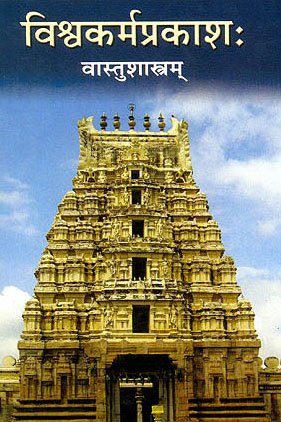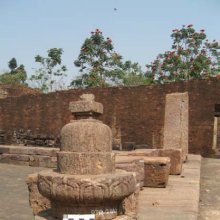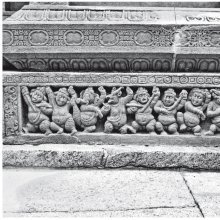Base: 2 definitions
Introduction:
Base means something in Hinduism, Sanskrit. If you want to know the exact meaning, history, etymology or English translation of this term then check out the descriptions on this page. Add your comment or reference to a book if you want to contribute to this summary article.
Images (photo gallery)
(+67 more images available)
In Hinduism
Vastushastra (architecture)
Source: Shodhganga: Elements of Art and Architecture in the Trtiyakhanda of the Visnudharmottarapurana (vastu)The Base part of the Temple (in ancient Indian architecture) is denoted by Sanskrit term Jagatī, according to the Viṣṇudharmottarapurāṇa, an ancient Sanskrit text which (being encyclopedic in nature) deals with a variety of cultural topics such as arts, architecture, music, grammar and astronomy.—Jagatī means moulding of a Base or the platform of any construction. According to Viṣṇudharmottarapurāṇa, it should be divided according to the section of the temple. [...] According to Matsyapurāṇa, four parts of the particular ground chosen for the site of a temple is considered as jagatī i.e the Base of the temple

Vastushastra (वास्तुशास्त्र, vāstuśāstra) refers to the ancient Indian science (shastra) of architecture (vastu), dealing with topics such architecture, sculpture, town-building, fort building and various other constructions. Vastu also deals with the philosophy of the architectural relation with the cosmic universe.
Languages of India and abroad
Kannada-English dictionary
Source: Alar: Kannada-English corpusBase (ಬಸೆ):—
1) [noun] a female elephant.
2) [noun] a barren cow.
--- OR ---
Base (ಬಸೆ):—[noun] any of several white or yellowish greasy substances, forming the chief part of adipose tissue of animals and also occurring in plants, that when pure are colourless, odourless and tasteless, used in the manufacture of soap, paints, and other protective coatings; fat.
--- OR ---
Bāse (ಬಾಸೆ):—[noun] a thin, vertical line of hair running from the bosom to the lower part of the belly.
--- OR ---
Bāse (ಬಾಸೆ):—
1) [noun] communication by voice in the distinctively human manner, using arbitrary sounds in conventional ways with conventional meanings; speech.
2) [noun] a body of words and the systems for their use common to a people who are of the same community or nation, the same geographical area or the same cultural tradition; a language.
3) [noun] a solemn promise made to a deity, saint, etc. committing oneself to an act, service or condition; a vow.
4) [noun] a declaration that something will or will not be done, given, etc., by one; a promise.
Kannada is a Dravidian language (as opposed to the Indo-European language family) mainly spoken in the southwestern region of India.
See also (Relevant definitions)
Starts with: Base gold, Basedoru, Basega, Basegedu, Basegodu, Basehina, Basele, Baselesele, Basella alba, Basen, Baseng, Basera, Basevakki, Baseven, Basevennu, Baseyili.
Ends with: Habashi, Mind Base, Nibase, Tabase, Vibashe.
Full-text (+2091): Hina, Nica, Bhumi, Abadha, Bhujaphala, Tala, Adhara, Pamara, Murdha, Adhishthana, Asthan, Kupya, Nikritin, Nikrishta, Akulina, Kamaasala, Alambana, Akupya, Hinaseva, Bhujajya.
Relevant text
Search found 336 books and stories containing Base, Bāse; (plurals include: Bases, Bāses). You can also click to the full overview containing English textual excerpts. Below are direct links for the most relevant articles:
Visuddhimagga (the pah of purification) (by Ñāṇamoli Bhikkhu)
Dependent Origination (vi): Contact < [Chapter XVII - Dependent Origination (paññā-bhūmi-niddesa)]
A. Description of the Bases (āyatana) < [Chapter XV - The Bases and Elements (āyatana-dhātu-niddesa)]
Dependent Origination (v): The Sixfold Base < [Chapter XVII - Dependent Origination (paññā-bhūmi-niddesa)]
Bhagavati-sutra (Viyaha-pannatti) (by K. C. Lalwani)
Part 5 - On the base of space < [Chapter 6]
Chapter 8: Camara-cañcā (capital city of Camarendra) < [Book 2]
Part 2 - The shape of the universe < [Chapter 1]
The Catusacca Dipani (by Mahathera Ledi Sayadaw)
The Twelve Ayatana Bases < [Part I - The Manual Of The Four Noble Truths]
Part II - The Burden of Dukkha in the Deva World < [The Exposition Of Four Characteristics]
Sahitya-kaumudi by Baladeva Vidyabhushana (by Gaurapada Dāsa)
Text 9.17 < [Chapter 9 - Ornaments of Sound]
Text 9.29 [Śleṣa] < [Chapter 9 - Ornaments of Sound]
Text 9.22 < [Chapter 9 - Ornaments of Sound]
Conditions (by Nina van Gorkom)
Chapter 9 - Prenascence-condition And Postnascence-condition
Chapter 6 - Dependence-condition
Patthana Dhamma (by Htoo Naing)
Related products
(+277 more products available)











